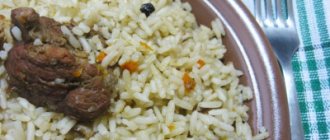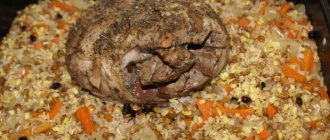Any cook, with much or little cooking experience, can add too much salt to a dish. Pilaf contains a large amount of rice, which absorbs fat, water, as well as salt and spices added to them. Because of this, many people have the problem of adding too much salt. How to fix pilaf if it has been over-salted, will it spoil the taste? Most often, the problem can be solved without losing the classic aroma and traditional taste.
What to do if you over-salted pilaf in a cauldron
If the pilaf in the cauldron is over-salted during the cooking process (between adding spices and rice), then solving the problem is very simple. You need to add a little more rice and do not salt it at all.
If the pilaf is over-salted after adding rice, then the best thing you can do is boil a portion of the cereal separately without adding salt. It is then added to the pilaf and simmered for another 10-15 minutes over low heat to allow the flavors to combine.
Advice! If there is no more room in the cauldron, put part of the pilaf in a separate pan and add clean boiled rice to the remaining pilaf.
The remaining salty part can be used to prepare cabbage rolls, stuffed peppers, or other dishes.
Another interesting way that will help remove excess salt from rice that has just been put in a cauldron is potatoes. Peel several medium-sized root vegetables, drown them in rice, and boil for 5-15 minutes. Then carefully remove with a slotted spoon. Instead of potatoes, you can use a gauze bag with dry rice. Place it in the cauldron while the cereal is stewing, cover with a lid and cook for 20-25 minutes. First, the gauze bag needs to be submerged a little in the main rice.
You can remove excess with the help of pomegranate seeds - a traditional method of correcting the salinity of a dish in Uzbekistan. Place fresh grains in a 2-4 cm layer into a cauldron, directly onto the rice, and leave for 20-30 minutes. Then, together with the pomegranate, they are laid out on plates. In addition to the fact that this method eliminates salt, it corrects the fat content of the dish. Instead of fresh grains, you can use natural pomegranate juice without sugar or syrup.
How to save over-salted soup?
What to do if the soup is too salty? In this case, the same rice can help. You need to put a bag of it in the broth. Nowadays they sell special rice that is cooked directly in the package; you can also wrap the cereal in gauze. While in the soup, the rice will absorb all the excess salt.
Potatoes also have good absorbent properties. You can put a few raw potatoes in the pan and boil them for about five minutes and then remove them.
If at the right time there were neither potatoes nor flour at hand, then you can use flour. It is poured into cheesecloth and then dipped into the soup. But this method has minor drawbacks: the broth becomes cloudy. You can lighten it with minced meat or beaten egg white, and then strain.
If you prepared a clear broth, but it turned out to be too salty, then you can add a little noodles to it, it will take away some of the salt. But it is worth remembering that you cannot overcook the noodles, otherwise the broth will become cloudy. And before serving, you can simply remove it.
There is a more extravagant way to remove excess salt from soup. You can overcome the unnecessary taste by adding a piece of sugar (refined sugar) to the broth. You should not dilute it with water, as it will become too watery, cloudy, and will also lose its taste, beneficial properties and aroma.
As one way to save the first dish, you can dilute it with a new portion of unleavened broth.
What to do if you over-salted pilaf in a frying pan
If there is too much salt in pilaf cooked in a frying pan, you should cook some rice and vegetables separately, add to the dish and fry. Instead of boiling, some cooks prefer to fry vegetables in a separate frying pan.
Advice! Barberry is a universal spice that will remove excess salt from pilaf, regardless of the method of its preparation. Just add more dried berries at the rice or zirvak stewing stage.
Another extreme way to eliminate the error is to rinse part of the dish. You can carefully remove some of the rice with a slotted spoon, rinse in cold water, and add back. If the dish has already been mixed in a frying pan, then it is even easier to save it using the same method. Just simmer for another 15-20 minutes after rinsing.
How to fix overcooked rice?
If you are lazy and overcook the rice for a side dish, drain the excess water from it, transfer it to a colander and rinse thoroughly under water. Add the resulting mass with mushrooms or onions and fry in oil - you get a completely edible dish.
Or make zrazy or cutlets from it - that’s also a good option.
Well, that's probably all. Remember and record for yourself everything described above. But it’s better to be careful when preparing food, try not to leave the kitchen for a long period. Let your dishes always turn out successful and tasty!
All the best!
Irina Kalinina shared her secrets for correcting culinary mistakes.
By
What to do if you over-salted pilaf in a slow cooker
If the housewife has over-salted the pilaf in the slow cooker - women most often cook the dish in this miracle of technology - then the situation can be corrected using all the methods that are used for a cauldron. Separately, you can cook a small amount of rice, and then add it to the bowl and stir, simmer for another 10-15 minutes in the “Pilaf” or “Stew” mode.
A popular way to eliminate the error is to add pomegranate seeds to the top of the multicooker bowl. The non-standard taste is easily masked by oversalting. If the dish is not intended for a festive table, then the matter is even simpler. Try adding herbs or, for example, an Italian herbs mixture.
Another unusual method that can also be used to eliminate over-salting in a saucepan, cauldron or frying pan is adding raisins. You can use any variety: golden, white, black. At the same time, light dried grapes remove excess salt better than others. You need to add dried fruits during the process, when there are at least 20 minutes left until the end of cooking. There is no need to pre-soak them - they will steam in the rice themselves.
We'll have to tinker
It’s a little more difficult to correct the situation if you happen to over-salt the soup. It would seem that there is nothing simpler: add water to such a soup and cook a little more. But leave this method as a last resort, otherwise you risk hopelessly ruining the taste of the soup. It’s great if you have unsalted broth in stock - you can dilute the soup with it without any damage to its organoleptic properties. If you don't have such broth, try keeping a bag of rice in the soup. Rice is an excellent absorbent and will quickly absorb excess salt. Some housewives use refined sugar to correct the taste. A piece of sugar is placed in a tablespoon and immersed in the soup. The melted sugar is replaced with new sugar - and this is repeated several times until the salt level in the soup becomes acceptable. Regular potatoes and pasta are good absorbents. If your soup recipe allows it, just add more of these ingredients. If there are no potatoes in the original recipe, put a couple of peeled potatoes into the soup and remove after 10-15 minutes. The potatoes will absorb the salt and not spoil the taste of the soup.
Goulash and roasts that contain too much salt can be corrected with sour cream. The meat is placed in a cup with sour cream and allowed to cool. If you don’t want to bother with transferring the meat, add an unleavened butter or flour sauce to the bowl with the meat. A bland side dish can also save the situation.
Over-salted minced meat can be saved by finely chopped cabbage, raw zucchini or grated potatoes. These “additives” will make the cutlets even more tender and juicy. As a last resort, you can replay everything, and instead of cutlets, make meatballs or cabbage rolls, adding rice to the over-salted minced meat.
Tomatoes and other vegetables will remove excess salt from vegetable stew. Chop them finely and add them to the dish, which you continue to cook over the fire. Whole cooked vegetables will release excess salt if you pour boiling water over them and cook for a few minutes. Boiling water, of course, must be unsalted. Mushrooms can also benefit from bland sauces, an extra serving of new mushrooms, sour cream, or an unsalted side dish in the form of rice or mashed potatoes.
But, generally speaking, to prevent such situations from arising, you should not salt the dish immediately, but a few minutes before it is ready, or intentionally under-salt it. After all, it’s always easier to add salt than to correct something that’s too salty.
Source: www.edimdoma.ru
What to do if the finished pilaf is too salty
It is even easier to correct finished over-salted pilaf than at the stewing stage. To do this, you can use additional vegetables, sauces, additives:
- A fresh vegetable salad. Tomatoes, cucumbers and a lot of greens (cilantro, dill or parsley), mixed with olive or sunflower oil, will easily take on some of the salt during consumption.
- Boiled carrots. You can add separately boiled or stewed carrots to the finished dish. It neutralizes some of the salt.
- Braised cabbage. You can turn pilaf into lazy cabbage rolls by rectifying the situation by adding stewed white cabbage.
- Sour cream sauces. If you add unsalted sauce with sour cream, garlic and herbs to an over-salted dish, it will eliminate the excess additive.
- Lemon juice and sour berries. You can squeeze the juice from 1 lemon and add it in portions at the time of serving. The juice of sour cherries, honeysuckle, lingonberries and cranberries is also suitable for this. But currants or strawberries will be too sweet and fragrant.
- Rice and carrots. If the dish is very salty, you can add not only vegetables and grains to it separately, but also together. In this case, it is better to chop the vegetable on a grater, and not to give it the shape of cubes or cubes.
- Onions and carrots. Instead of the rice and carrot combination, you can use a fried onion and root vegetable combination. They should be taken in 500-700 g quantities, depending on the initial amount of pilaf.
- Butter. If there is not too much salt in the dish, then you can add 1 tsp to the plates in portions. melted butter from 72% fat.
- Tomato sauce. Homemade or store-bought tomato sauces without added salt are a great way to eliminate excess. You can choose classic recipes with herbs.
Over-salted pilaf can be saved if you use the methods suggested above.
If there is too much salt and nothing helps, the best way to eliminate the error is to prepare another dish based on the damaged recipe.
So, from a combination of onions, meat, rice and carrots you get delicious cabbage rolls, meatballs in sauce, stuffed zucchini, peppers, and eggplants.
☝ How much salt to put in pilaf and at what point
| Types of meat | Proportions of meat and rice | Amount of salt |
| Chicken | 300 g fillet and 250 g rice | 1 tsp |
| Pork | 500 g pork and 500 g rice | 1 tbsp. with a slide |
| Beef | 1 kg of meat and 500 g of rice | 1 tbsp. |
| Mutton | 700 g lamb and 700 g rice | 1.5 tbsp. |
For 1 kg of meat and 1 kg of rice, 1.5 tbsp is enough. l. salt.
Chicken and pork cook quickly, so add salt before adding rice. See pilaf recipes here.
Lamb and beef take longer to cook; it is better to add salt in stages: the first time while stewing the meat, the second time at the end, adding salt to taste.
The main guideline is your taste! Taste the pilaf and evaluate the degree of salinity during its preparation.









